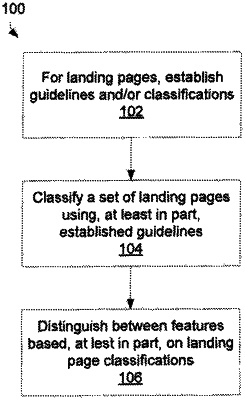| CPC G06N 5/04 (2013.01) [G06N 20/00 (2019.01); G06N 20/20 (2019.01); H04W 4/23 (2018.02); H04W 4/50 (2018.02)] | 20 Claims |

|
1. A method comprising:
identifying features of a landing page;
determining, based upon the features of the landing page, a combination of feature sets, comprising a combination of image-related features and markup language-related features, determined to be more discriminative at distinguishing between classes of mobile friendliness of the landing page than one or more other feature sets, wherein the image-related features comprise at least one of color-type features, texture-type features or contrast-type features;
selecting a machine learning (ML) classifier from among a plurality of ML classifiers based upon (i) testing a sample set of landing pages using the plurality of ML classifiers, (ii) determining that the ML classifier has a highest performance score amongst the plurality of ML classifiers, and (iii) comparing performance of the ML classifier with performance of a library tool configured with one or more defined library features;
predicting, based upon a processing of the combination of feature sets and the features of the landing page using the ML classifier, an ML classification of the landing page as to post-click user experience of a mobile device user,
wherein predicting the ML classification comprises:
traversing two or more trees associated with the landing page, from one or more root nodes to one or more leave nodes, based upon one or more rules specifying one or more ranges for one or more particular feature values,
wherein the traversing the two or more trees yields two or more different classes comprising:
a first class associated with a first tree of the two or more trees; and
a second class associated with a second tree of the two or more trees; and
determining a final class based upon at least one of a most frequent class or a more frequent class of the two or more different classes comprising the first class and the second class, wherein the ML classification is based upon the final class; and
delivering digital content for display on a mobile communication device based upon the ML classification.
|